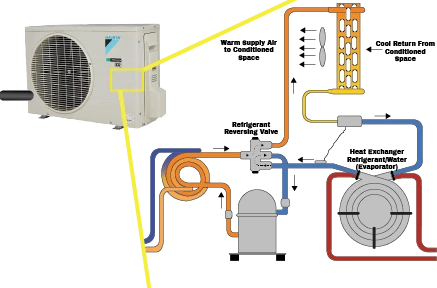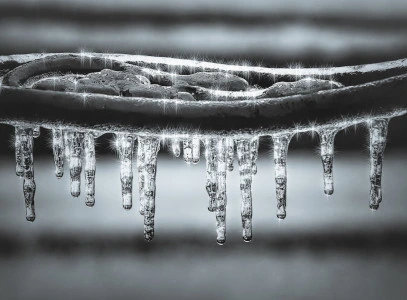How Does a Heat Pump Work in Winter?
In temperate climates, it’s becoming more common to find homes that just have a heat pump to handle their heating and cooling. The concept of how heat pumps work is pretty straightforward. It pulls heat from one unit and pumps it out the other. Either into your home or out of your home. However, the air outside is cold during winter and you want your heat pump to bring hot air inside, so how does a heat pump work in winter?
The simplest way we can put this is that the heat pump super cools one of its parts so that it’s cooler than the air outside. It’s then able to pull the heat from the air using that temperature difference.
Let’s think back to physics class. Cold is just the absence of heat. Heat wants to travel to where there’s no heat already. By creating a difference in temperature, a heat pump can pull heat from the outside air even when it’s 40 degrees Fahrenheit.
In this post, we’ll get into more detail on why that’s possible and how this incredible machinery works. We won’t get caught up on thermodynamics and will leave that to the engineers who create the HVAC equipment that keeps our homes comfortable.
Parts Involved
Your heat pump will use several parts to create heat for your home. Being acquainted with each part can help you better understand your heat pump and how it works.
In order these are:
- Refrigerant: The fluid in the coils and pipes.
- Compressor: The outdoor unit that absorbs or expels heat outside
- Air Handler: This is the indoor unit that heats or cools air and connects to the head(s) or ducts.
- Head: This unit attaches to a wall and blows air for a ductless unit.
In the rest of this article, we’ll go part by part and explain how they are used to create heat.
Reverses The Refrigerant
The first thing we need to know to understand how a heat pump works in winter is that in cools its refrigerant below the temperature of the air outside. It does this by reversing the flow of that refrigerant.
In summer, the refrigerant in a heat pump flows one direction. Going that way allows it to pull heat from your home and pump it outside, cooling your home.
By using a unique part called a reversing valve, a heat pump can cool the refrigerant in the outside unit below the temperature of the air outside.

Doing that allows the outdoor unit to capture heat from the air outside and pump it into your home. Think of it like an AC unit working in reverse.
Special Refrigerant
In order for this process to work, heat pumps use a special refrigerant, R-410.
This refrigerant has a boiling point of 14 degrees Fahrenheit. This allows it to be cool and a heat conductor at the same time.
Outdoor Unit
Once the refrigerant absorbs the heat from the outside air, the outdoor unit takes over. The outdoor unit of a heat pump is called a compressor. What it does is compress the refrigerant once it has absorbed the heat. This superheats the refrigerant to 104 degrees Fahrenheit.
Indoor Unit
Once that refrigerant gets hot, it then runs through the refrigerant lines to the indoor unit, or air handler. Once inside, the refrigerant flows through the A-Coil and stays over 100+ degrees. Air circulates over the A-Coil in that air handler and absorbs the heat from the refrigerant in the coil.

Fans and Ductwork
Once the air reaches the temperature set by the thermometer, a fan turns on and blows the hot air through your ducts, or the head unit if you have a ductless system.
Heat Pumps Can Adjust Settings
This entire process of reversing, heating, and flowing the refrigerant took the heat pump a matter of seconds. Heat pumps are sophisticated and run efficiently if installed correctly. They have a wide array of sensors in both the indoor and outdoor units, so they know how just how much they need to cool their refrigerant to make this process work.
Depending on where you live, running a heat pump maybe more efficient than running a furnace and AC unit. Ask your local HVAC sales professional if a heat pump can help you save energy.
What to Look Out For
So, now we know how a heat pump works in winter, but is there anything you need to look out for while it’s heating your home? Like any piece of equipment, heat pumps have their limits.
Here are some things to look out:
- Constantly in Defrost Mode
- Too Cold Outside
- Emergency Heat
Defrost Mode
Sometimes you might notice that your heat pump is in “Defrost Mode.” This is normal and an important part of a heat pump’s process. Any ice build up can inhibit a heat pump’s ability to heat your home. When a heat pump is in defrost mode, it is thawing ice off its outdoor unit. This is normal and something that the heat pump does.
This becomes an issue if your heat pump is constantly in defrost mode. If you notice that your heat pump cannot heat your home and is always defrosting its outdoor unit, then you might need a secondary heat source.
How Cold is Too Cold?
There is a limit when a heat pump stops being efficient. This is typically around 40 degrees Fahrenheit or below. A heat pump cannot cool, it’s refrigerant enough to absorb a sufficient amount of heat.
Emergency Heat
When your heat pump cannot absorb heat the way it normally does, you may notice that it will be in Auxiliary Heat. If you only have a heat pump and not a furnace as a backup heat source, then this will impact your system’s performance. Auxiliary heat means that the heat pump is using a set of electric strips or resistance heating to heat air in the air handler.

This mode of running is much less efficient, and you will notice an increase in your power usage. If the heat pump uses this mode for an extended period, then you will have a noticeable increase in your power bill.
If this happens on only a few days out of the year, then it means your heat pump is running as intended. If you find your heat pump is on auxiliary heat for several days or weeks in a row, then you might need a secondary form of heating like a furnace.
Who Are Advantage Heating and Air Conditioning, LLC?
We are your local HVAC Experts out of Salem, Oregon. We hope that this post gave you the information you need to know to figure out how a heat pump works in winter. If you have other questions about HVAC systems, check out our other blogs. To learn more about who we are and how we can help you, visit our website and follow us on social media – we’re here when you need us!





